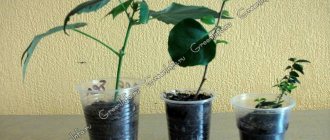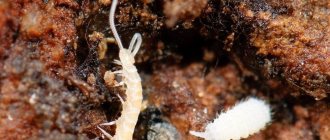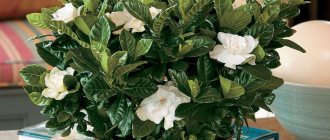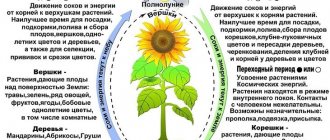Vegetative propagation is carried out due to the division of cells of the vegetative organs of plants.
The following methods of vegetative propagation of plants are known: 1) using modified shoots (tubers, bulbs, rhizomes, stolons); 2) parts of vegetative organs (stems, leaves, roots); 3) grafting (kidneys).
Reproduction by modified shoots
Plant propagation by rhizomes is widely used in landscaping areas, squares, and schoolyards. The rhizomes of plants such as iris and lily of the valley are divided into parts so that 2-3 buds remain on each segment and planted in the soil. A plant develops from each part of the rhizome. Next year it may already bloom. Initially, rhizomatous plants produce 1-2 shoots, then their number increases annually (Fig. 1).
Fig.1 Rhizome of lily of the valley
Potatoes are most often propagated by tubers. If the tuber is large, it is divided in half or into several parts, leaving 1-2 eyes on each of them (Fig. 2).
Fig.2 Propagation by tubers
Onions, garlic, lilies, tulips, hyacinths and many other plants reproduce from bulbs. This method of propagation makes it possible to cause flowering even in winter (Fig. 3).
Fig.3 Tulip propagation by bulbs
Strawberries are most often propagated by stolons. At the point where the long whiskers touch the ground, adventitious roots appear. Then a shortened shoot develops. Having separated the young rosettes from the whiskers, they are seated (Fig. 4).
Fig.4 Propagation of strawberries by stolons
Palm trees
Palm trees reproduce using seeds. In order to grow a palm tree from seeds, they need to be sown in a light, sandy substrate and covered with cellophane. In order for your seeds to germinate, you should warm the soil to 26 - 28 degrees and prevent the substrate from drying out. Basically, the germination time of seeds depends on the type of palm tree you choose.
For some, the time is from ten to twelve days, while others require 5 to 6 months (for example: coconut). Your seedlings should be placed in a warm but not sunny place. Palm trees need to be planted only when their height is at least fifteen centimeters.
Reproduction by parts of vegetative organs
Young shoots can be obtained from the stem, leaf, or root. The part of the stem with buds used for propagation is called a cutting. For propagation of willow, poplar, maple, grapes and other plants, winter (without leaves) and summer (with leaves) shoots are used (Fig. 5).
Fig.5 Propagation by cuttings
In home gardening, propagation by layering is widely used. To do this, a branch, for example a currant, is bent to the ground, secured and sprinkled, leaving the top above the soil. The rooted cuttings are separated from the mother plant and planted in a designated area (Fig. 6)
Fig.6 Reproduction by layering
Perennial decorative flowers (carnations, pelargonium, coleus, tradescantia, ficus, etc.) are propagated from green stem shoots. To do this, a young shoot 10-15 cm long is separated from a houseplant, planted in a flower pot with previously prepared soil (the bottom of the pot is filled with 1-2 cm of sand) and watered (Fig. 7).
Fig.7 Reproduction by stem shoots
Begonia and violets can be propagated by leaves or even parts of them. And in bryophyllum, small rosette shoots, already with roots, develop right on the edge of the leaf blade of the mother plant (Fig. 8).
Fig.8 Reproduction by leaves
Daisies, gooseberries, raspberries, currants, etc. are propagated by dividing the bush. Rose hips are often planted as a green hedge, which is propagated by dividing the root and root cuttings. The formation of adventitious buds on the roots gives rise to root shoots. Adventitious roots grow from these shoots. Over time, they separate and become independent. Even small pieces of root (1-4 cm), which have accessory buds, give rise to new above-ground shoots.
How to get a new flower from leaves
There are three ways:
- whole leaf;
- a piece of leaf;
- whole leaf with petiole.
Leaf without division
Whole leaves are used for plants with thick, succulent leaves, like Rex begonia.
Propagation by whole begonia leaf
The veins of the prepared planting material are cut from below. Before propagation, planting material is dried. Coarse sand is poured into a container with good soil on top and spilled. The sheet should be placed on the bottom side and pressed a little.
A piece of leaf
This option is suitable for:
- Royal begonia;
- Mason Begonias;
- sansevierias;
- Streptocarpus.
The leaves are cut into pieces no larger than five centimeters. Planting is done using prepared soil. You can use compositions for indoor flowers, which are sold in specialized stores. The leaf plate should not come into contact with the soil; it should be supported by a support.
When favorable conditions are created (high humidity, warm air and watering), the root system forms quickly.
Whole leaf with petiole
A leaf with a petiole is a good material for obtaining:
- Saintpaulium;
- gloxinia;
- begonia.
The leaf should be taken from a healthy plant at the base. Use a sharp knife for cutting. The length of the petiole is usually 1 or 3-4 cm.
Propagation by leaf cuttings of Saintpaulia
You can get the root system in different ways:
- Place the leaf in a container of water. The petiole should be long, up to 4 cm.
- When rooting in the ground, the petiole is shortened to one centimeter. The cut is treated with a phytohormone solution. The leaf is placed directly into the hole with the bottom side facing the wall of the container. Planting material should not be allowed to come into contact with the ground.
Reproduction by grafting
Grafting is the grafting of a part of one plant (scion) onto a rooted seedling of another plant (rootstock). This method of vegetative propagation is most often used by gardeners to create new plants that are resistant to cold and pests with the desired taste qualities. For example, to create cold-resistant varieties of fruit trees, a cutting of a cultivated plant is grafted onto a wild shoot (a shoot grown from a seed). The cold resistance of the rootstock (wildstock) is transferred to the shoots developed from the grafted part of the cultivated plant. There are more than 150 methods of vaccination. Of these, the most commonly used are cutting grafting and eye (bud) grafting.
Grafting with cuttings (copulation) is carried out by transplanting a cutting with buds from one plant onto an oblique cut of a rootstock branch of the same thickness. The tightly connected parts should grow together (Fig. 9).
Fig.9 Copying
To graft with an eye (budding), a bud is cut from a cultivated plant, capturing a small part of the stem (bark and wood). A T-shaped cut is made on the rootstock bark. Then, with the blunt end of a budding knife, turn off the corners of the bark and insert a piece of scion bark with a bud the same length as the cut. After this, the graft is tied with a narrow strip of special film, leaving the bud open (Fig. 10).
Fig. 10 Budding
In specially equipped laboratories, new plants are grown from cells of educational tissue. Vegetative propagation is propagation by vegetative organs (root, stem, leaf) by their parts or modifications (rhizome, tuber, bulb, stolons).
Lily of the valley and iris reproduce by rhizome; tubers - potatoes; bulbs - onion, garlic, lily; mustache-stolons - strawberries, wild strawberries. Willow, poplar, and grapes are propagated using parts of the stem—cuttings; Violet and begonia are propagated using leaves, and raspberries and rosehips are propagated by parts of the root with adventitious buds. Grafting is a method of grafting a part of one plant with a bud onto another plant. Stem
Shoot and bud
External and internal structure of the leaf
cacti
Cactus cuttings
Cacti are propagated using cuttings, which should be dried for two days before planting. Root in semi-dry sand. Flowers must be sprayed with water at room temperature two to three times a day, which greatly facilitates the rapid formation of roots in the plant. When it is too hot, it is advisable to protect your sprouts from sunlight. After good rooting, the plants can be transplanted into separate pots.
The method of propagating cacti by cuttings is used only in the spring or at the very beginning of summer. This condition is very important for the future life of the cactus, but many flower lovers and “cactus growers” neglect this rule.
The main component in propagating a cactus by cuttings is that the cutting must successfully take root in its new location. At the same time, the grafted apical cactus develops its own root system. The grafted cuttings, before the onset of a lull in flowers (autumn, winter), will become one with the main plant to which it was grafted. By the way, the need to comply with this rule, in turn, guarantees the condition that the mother plant also tolerated its vulnerability normally and successfully.
With the onset of winter, there are frequent cases when the mother houseplant “bends over”. This occurs due to the fact that during the dormant period, flowers are not at all able to resist various infections and microbes can easily get into the wound of the mother plant that has not yet healed.
To prevent a negative result when propagating a cactus by cuttings, immediately after pruning, apply a layer of sulfur or coal dust to the cut of the plant. With this procedure, sulfur will mix with cactus juice and form a film that reminds us of a plaster; in this case, the cut dries faster and does not leave a depression.
It should be noted that the most viable and strong cuttings are usually at the tops of plants, which is also observed in cacti. When propagating a cactus by cuttings from rhipsalis, cereus and prickly pear, the cuttings should be cut in places where they connect to the stem, and in the epiphyllum the plates are cut wedge-shaped, just below the deltoid branching.
It is not recommended to keep cut cuttings in the open air and sun, but warmth promotes faster development of the root system. Many growers help flowers develop by using a 'heating device' such as a heating pad wrapped in a blanket.
A bowl with cuttings is installed on such an improvised incubator. The water in the container must be changed three times a day as it cools. This process is quite troublesome, but in gratitude you will delight yourself with wonderful and amazing cacti for many years.
It is imperative to know and remember that when propagating a cactus by cuttings, you should water the indoor plant only for the first month, so that the grafted cuttings take root properly. In the future, watering must be gradually reduced. Starting from September and throughout the winter period, cacti have little need for water and watering can be reduced to a minimum.
Reproduction of cactus by children
In the event that your flower cannot produce shoots, branching of the stems can be achieved artificially. In this case, you should remove the top of your plant and then the remaining stump will quickly become overgrown with children in a short time. Next, carefully cut off the baby and plant it in a shallow pot. We use a special “cactus mixture” as the planting substrate.
Vaccination
There are some types of cacti that grow very poorly on their own roots. In this case, a simple vaccination is necessary. This procedure is performed as follows: take a cactus with a strong root system (rootstock) and cut off the upper part of the plant. Next, take the top of another cactus and connect it together. Plants with spherical or cylindrical shapes are grafted into the butt. If the cacti are of a different shape, they are grafted into splits. Plants should be grafted in the spring. The grafting method guarantees you: the best, high-quality reproduction; accelerated plant growth; earlier and more abundant flowering of flowers.
Test on the topic: “Vegetative propagation of plants”
Time limit: 0
Navigation (job numbers only)
0 out of 15 tasks completed
Questions:
- 1
- 2
- 3
- 4
- 5
- 6
- 7
- 8
- 9
- 10
- 11
- 12
- 13
- 14
- 15
Information
The verification test task includes questions with one or more correct answers.
You have already taken the test before. You can't start it again.
The test is loading...
You must log in or register in order to begin the test.
You must complete the following tests to start this one:
results
Correct answers: 0 out of 15
Your time:
Time is over
You scored 0 out of 0 points (0)
| Average result |
| Your result |
Categories
- Botany 0%
maximum of 20 points
| Place | Name | Recorded | Points | Result |
| Table is loading | ||||
| No data | ||||
Your result has been recorded in the leaderboard Loading
- 1
- 2
- 3
- 4
- 5
- 6
- 7
- 8
- 9
- 10
- 11
- 12
- 13
- 14
- 15
- With answer
- With a viewing mark
- Task 1 of 15
1.
Vegetative reproduction occurs through cell division
Right
Wrong
- Task 2 of 15
2.
Tubers are most often propagated
Right
Wrong
- Task 3 of 15
3.
Carnations, pelargonium, coleus, tradescantia, ficus are propagated
Right
Wrong
- Task 4 of 15
4.
Most often they are used by gardeners to create new plants that are resistant to cold and pests with the desired taste qualities.
Right
Wrong
- Task 5 of 15
5.
For budding, they cut from a cultivated plant
Right
Wrong
- Task 6 of 15
6.
Winter and summer shoots are used for propagation
Right
Wrong
- Task 7 of 15
7.
Reproduces by stolons
Right
Wrong
- Task 8 of 15
8.
Begonia and violet can be propagated
Right
Wrong
- Task 9 of 15
9.
Propagated by dividing the bush
Right
Wrong
- Task 10 of 15
10.
Part of the stem with buds used for propagation
Right
Wrong
- Task 11 of 15
11.
As a result of vegetative propagation, young shoots can be obtained from
Right
Wrong
- Task 12 of 15
12.
A method of vegetative propagation that allows flowering to occur even in winter
Right
Wrong
- Task 13 of 15
13.
Propagated by rhizomes
Right
Wrong
- Task 14 of 15
14.
Propagated by bulbs
Right
Wrong
- Task 15 of 15
Bidens
Under such a sonorous name there is a decorative form of string on sale. Bidens, or vegetative string (Bidens, or Coreopsis ferulifolia) is usually a hanging plant with thin drooping shoots, which is used for hanging baskets. Additional decoration is carved foliage.
Flowers most often vary between different shades of yellow. But there are also hybrids with variegated flowers, for example, ' Bidy Bop Flame' - bright orange centers and yellow tips of the petals. The shape of the flowers is similar to daisies or rather like tiny sunflowers. Flowering is long and very abundant.
Bidens, or vegetative sequence (Bidens). © tijardin
Purslane
Vegetative purslane (Portulaca oleracea) differs significantly from seed purslane, and it is not always easy to identify the usual purslane in this plant. This succulent has the same plump, succulent leaves, but they are flatter and have rounded edges. The flowers of vegetative purslane are approximately half the size of seed ones, but the bushes bloom very profusely. In cloudy weather, the corollas, like those of seed purslane, are closed.
Basically, vegetative purslane is found in two colors: bright yellow and orangeish. Recently, double varieties of such purslane and variegated varieties have begun to appear on sale. When planting purslane next to other plants, keep in mind that it grows strongly and quickly.
Purslane (Portulaca oleracea). © MarishaZ
Lobelia
Lobelia is another fairly popular and already somewhat familiar summer plant, whose vegetative forms literally amaze the imagination. For example, could you imagine terry lobelia? But it really exists and spreads, like all “vegetatives,” only in the form of rooted cuttings.
Terry lobelia has the same small bright blue flowers with a white center, but they consist of many petals and look like small original roses. There is also another interesting variety of vegetative lobelia ' Star Super' , which differs from the seed ones by a larger spot in the center and a slightly different flower shape (more oval).
Lobelia, variety 'Star Super'. © Lyudmila Svetlitskaya
Scaevola
In the West, Scaevola is a very popular plant and can often be seen in container arrangements. In our country, this flower was completely unknown for a long time, since it is still almost impossible to find its seeds on sale. At the same time, seed propagation of this plant is in principle possible. But now, at last, it has become possible to purchase rooted cuttings of this original flower.
Scaevola is an ampelous or cushion-shaped bush, strewn with small (up to 2.5 centimeters) fan-like flowers, which are collected from the inflorescence. The color of the petals is mainly blue-violet: from soft blue to deep purple. The corolla can be pure white, less often yellow. It blooms very profusely all summer.
Scaevola. © Charles W. Prince
Petunia
I think I will not be mistaken if I assume that petunia (Petunia) has the richest variety of vegetative hybrids among all annuals. And no matter how beautiful the seed varieties are, the most amazing petunias can still be found among those that are propagated by cuttings. For example, densely double small-flowered forms, which look very charming and original, exist only in vegetative petunias.
The most popular of them are petunia “Tumbelina Priscilla” (purple), “Tumbelina Melissa” (yellow). And there are simply countless non-double hybrids with unique colors! Moreover, most varieties of vegetative petunia are ampelous and form very long lashes, densely covered with flowers. Such petunias are more hardy and do not require removal of faded flowers.
Alyssum
It would seem, what can surprise such a simple plant with small honey-smelling flowers? And why buy its cuttings when Alyssum is so easy to grow from seeds and even self-sow?
As you know, varieties of alyssum grown from seeds are divided into two large groups: bush and hanging. The latter only hang slightly from the pot. But vegetative amel alyssum allows you to create a real trail of delicate flowers, because the length of the shoots of such hybrids is several tens of centimeters! The most powerful bushes and long shoots are found in the hybrids ' Lucia White' (white) and ' Lucia Purple' (lilac). Vegetative alyssum may also have larger flowers.











